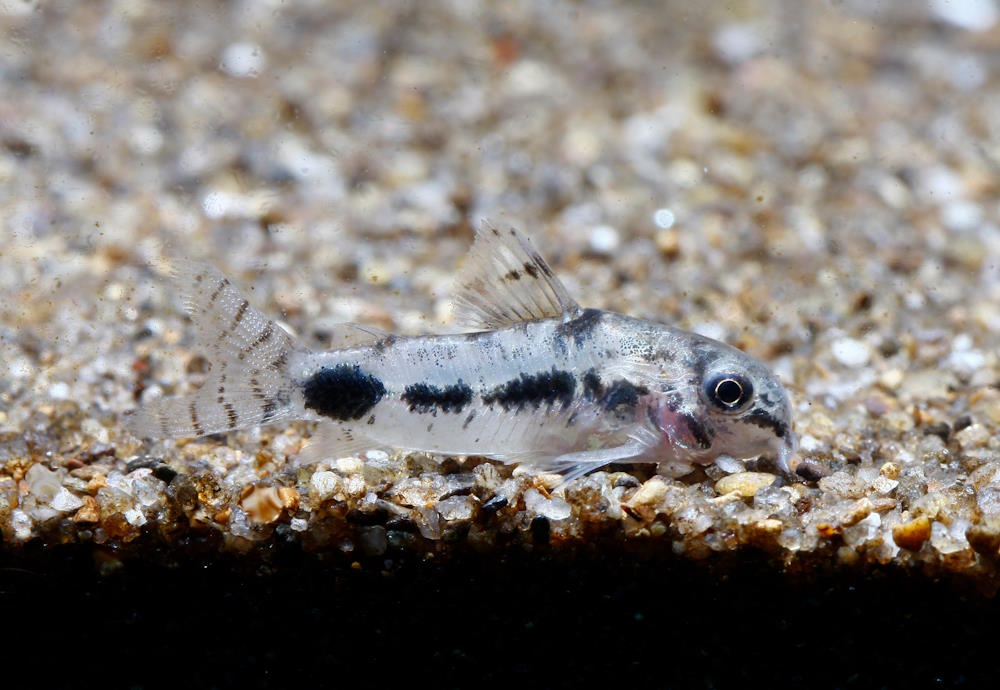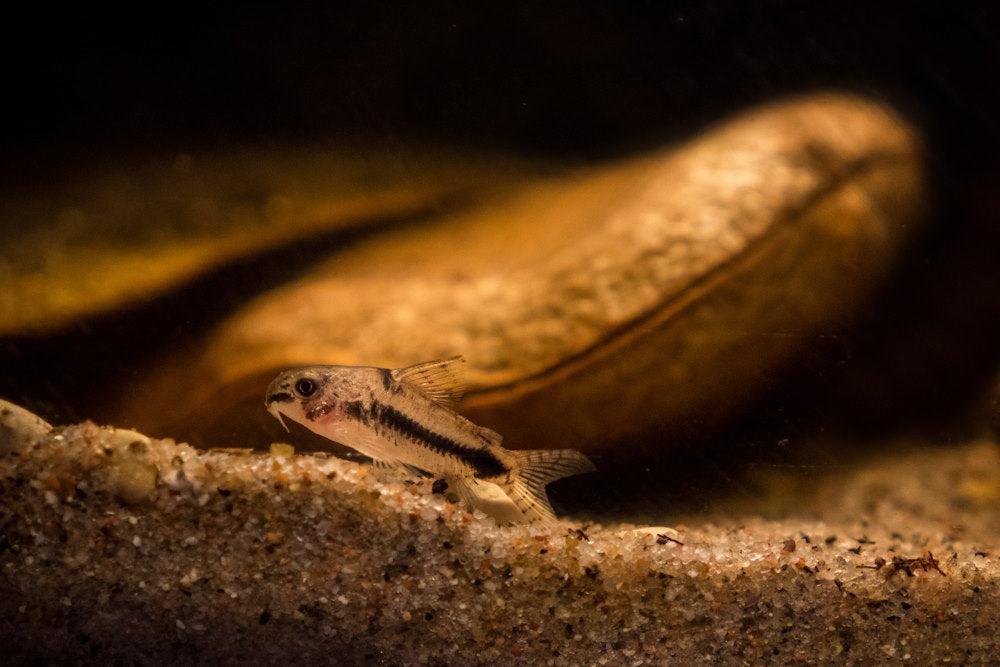Care Guide for Habrosus Corydoras — The Largest Dwarf Cory Catfish
Cory catfish are one of our favorite bottom dwellers because of their easy-going personalities, constant scavenging, and silly antics. With more than 150 Corydoras species to choose from, the salt and pepper cory is one of our best-selling fish at Aquarium Co-Op. Find out why these nano bottom dwellers are so popular and how to provide them with a comfortable environment to thrive in.

Salt and pepper cory in a planted tank
What are Habrosus Corydoras?
Corydoras habrosus is the largest of the three species of “dwarf corydoras,” with the round-bellied females reaching 1.5 inches (3.5 cm) and males being slightly smaller and slimmer. Unlike the other two dwarf corydoras that hover in the middle of the tank, habrosus corys prefer to swim near the bottom, using their little barbels or whiskers to search for food. They are very active yet peaceful critters that exhibit many of the unique personality quirks of their larger corydoras cousins. Expect to see them randomly dart up to the surface for a gulp of air or unexpectedly “wink” at you while resting on the ground.
What is the difference between the habrosus, hastatus, and pygmy cory? All three of these dwarf corydoras are similar in size and coloration. However, they have clear differences in their patterns that you can easily identify:
- C. habrosus (salt and pepper cory): silvery-tan body with an uneven, horizontal black stripe, a striped tail, and darker splotches on the head and back
- C. hastatus (tail spot cory): silvery body with a big, black spot at the base of the tail that is flanked by small, white dots
- C. pygmaeus (pygmy cory): silvery body with a thin, horizontal black stripe

Left to right: C. habrosus, C. hastatus, and C. pygmaeus
The common name “salt and pepper cory catfish” refers to the dappled markings on C. habrosus, but don’t confuse it for the “peppered cory catfish” or C. paleatus, which also has a mottled pattern but grows up to 2.5 inches (6.4 cm) long.
How to Set Up an Aquarium for Salt and Pepper Corydoras
The habrosus cory can be found in the flooded forests and slow-moving streams of Columbia and Venezuela that are chock full of underwater foliage and tree roots. Hundreds of them can be found congregating around the dense cover while sifting through the substrate. Therefore, we recommend using a filter with gentle flow with lots of live aquarium plants and driftwood to simulate their natural habitat. Because they are accustomed to the changing parameters introduced by the rainy seasons, you can keep them in pH of 6–8, 70–78°F (20–26°C), and soft to moderately hard water. A 10-gallon aquarium is a good starting point, depending on the size of the school and number of tank mates.
How many habrosus corys should be kept together? As a smaller schooling fish, they would feel most comfortable in a larger group of at least 8–12 other habrosus corys. The greater the numbers, the more you will see their delightful personalities shine.
What fish can live with habrosus corydoras? They are very mild-mannered and get along with virtually any peaceful community fish that isn’t big enough to eat them. Common tank mates include chili rasboras, celestial pearl danios, clown killifish, green neon tetras, snails, and other small catfish. They can live with adult dwarf shrimp but may opportunistically consume any baby shrimp or fish fry that cross their paths.

Salt and pepper cory on sand substrate
What Do Habrosus Cory Catfish Eat?
While they are excellent “vacuum cleaners” that will suck up any tasty morsels they find, cory catfish cannot live on leftovers alone and must be fed a variety of sinking fish foods to stay healthy. Also, they are not the fastest eaters and like to take their time foraging, so be careful about pairing them with fast swimmers that will gobble up every crumb before it ever hits the floor. We like to feed them a mixture of nano pellets, sinking wafers, frozen daphnia, baby brine shrimp, and live micro worms. Repashy gel food is one of their favorites since it stays solid in the water for up to 24 hours, allowing them to graze all day long to fill their little stomachs.

Habrosus corys love to eat meaty foods and generally do not go after algae or vegetables.
How to Breed Salt and Pepper Cory Catfish
Breeding habrosus corydoras at home is so fun. Like most corydoras, you can condition them for spawning by increasing the amount of food you feed them. Some breeders recommend having more males than females and doing frequent, large water changes with cooler, soft water to imitate the rainy season. When the female is plump and full of eggs, the males will start chasing her everywhere until she is ready to mate. The sticky, fertilized eggs are typically deposited on aquarium walls, plant leaves, or even a DIY spawning mop sunken to the ground.
The adults like to eat their own eggs, so either remove all the fish from the breeding tank or remove the eggs. The eggs can be gently rolled off with your finger, or you can remove the entire spawning mop if there are eggs in there. Corydoras eggs are prone to growing fuzzy fungus, so to increase the hatch rate, consider placing them in a catch cup with an air stone and adding a few drops of methylene blue or alder cones as an antifungal treatment. Once the fry have hatched, change the water to remove the methylene blue, and feed the newborns tiny sinking foods like vinegar eels, powered fry food, and raw Repashy powder. Keep the water quality high with frequent water changes, and as soon as they are big enough, start feeding live baby brine shrimp to significantly boost their growth.

Alder cones and other botanicals add brown tannins to the water and have very mild antifungal properties.
We hope you will give this petite catfish a chance the next time you’re setting up a nano (or larger) aquarium. While we do not ship live fish, you can check out our list of preferred online vendors to see the latest livestock they have available. Plus, we have many more corydoras species to suggest, so read our article on the 10 Best Cory Catfish You Have to Try.




